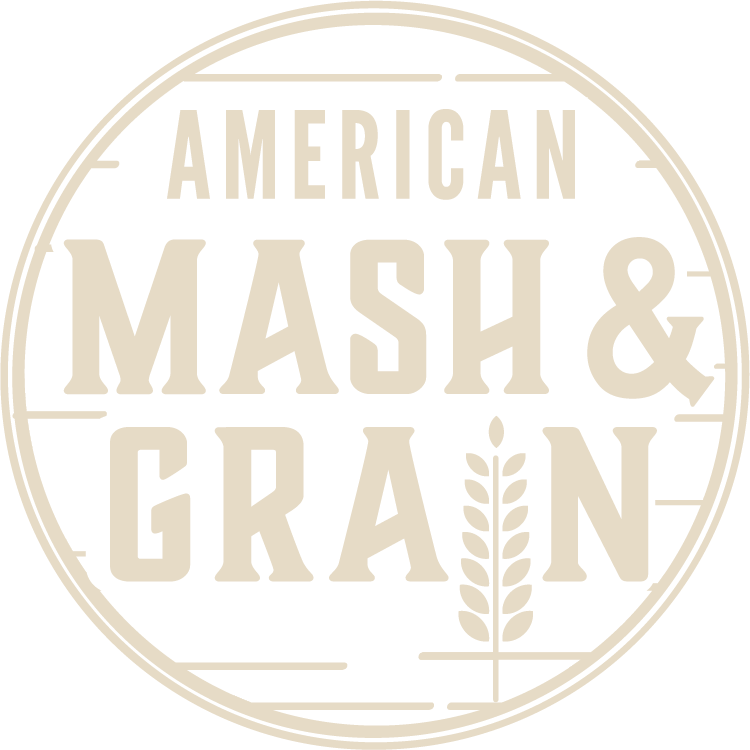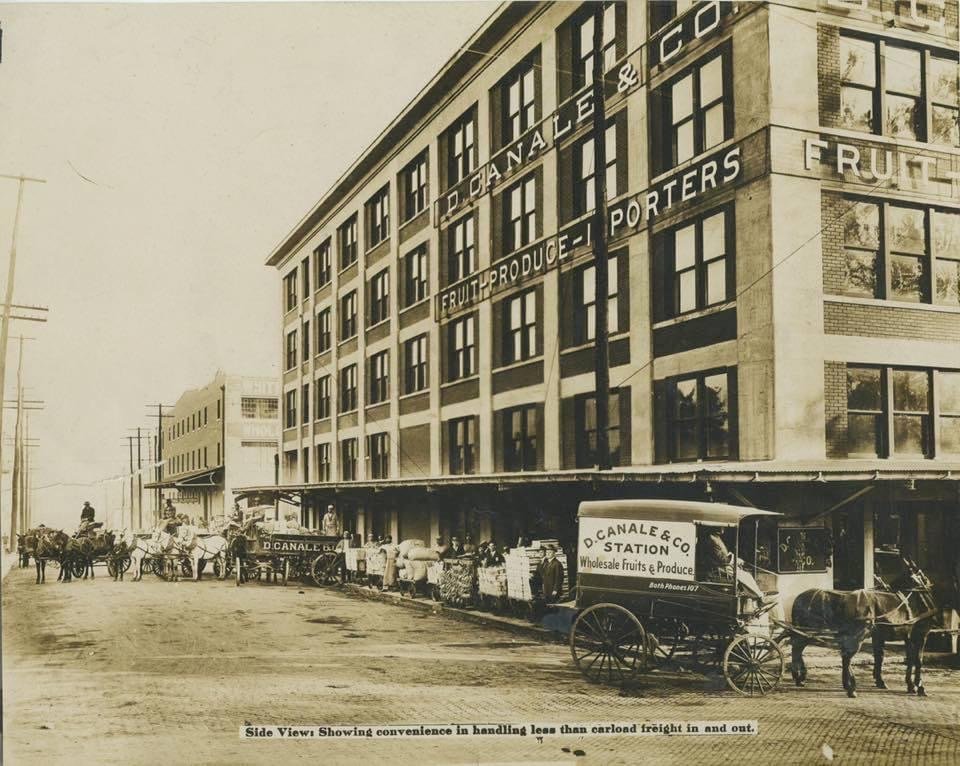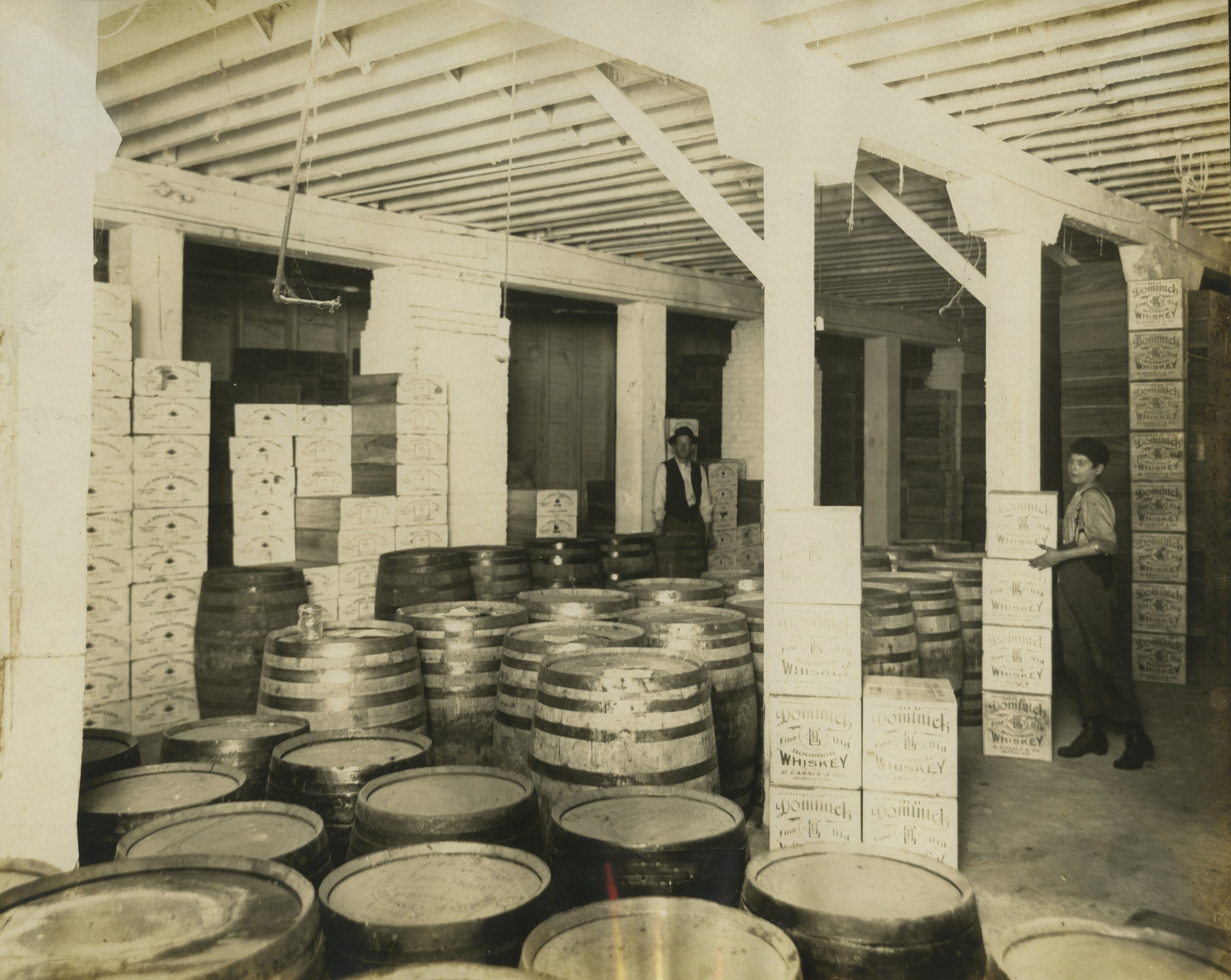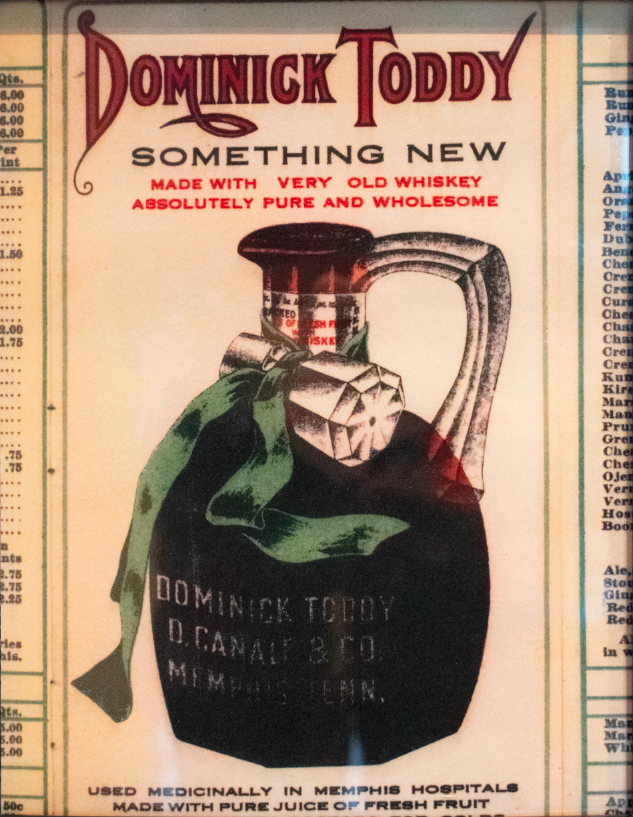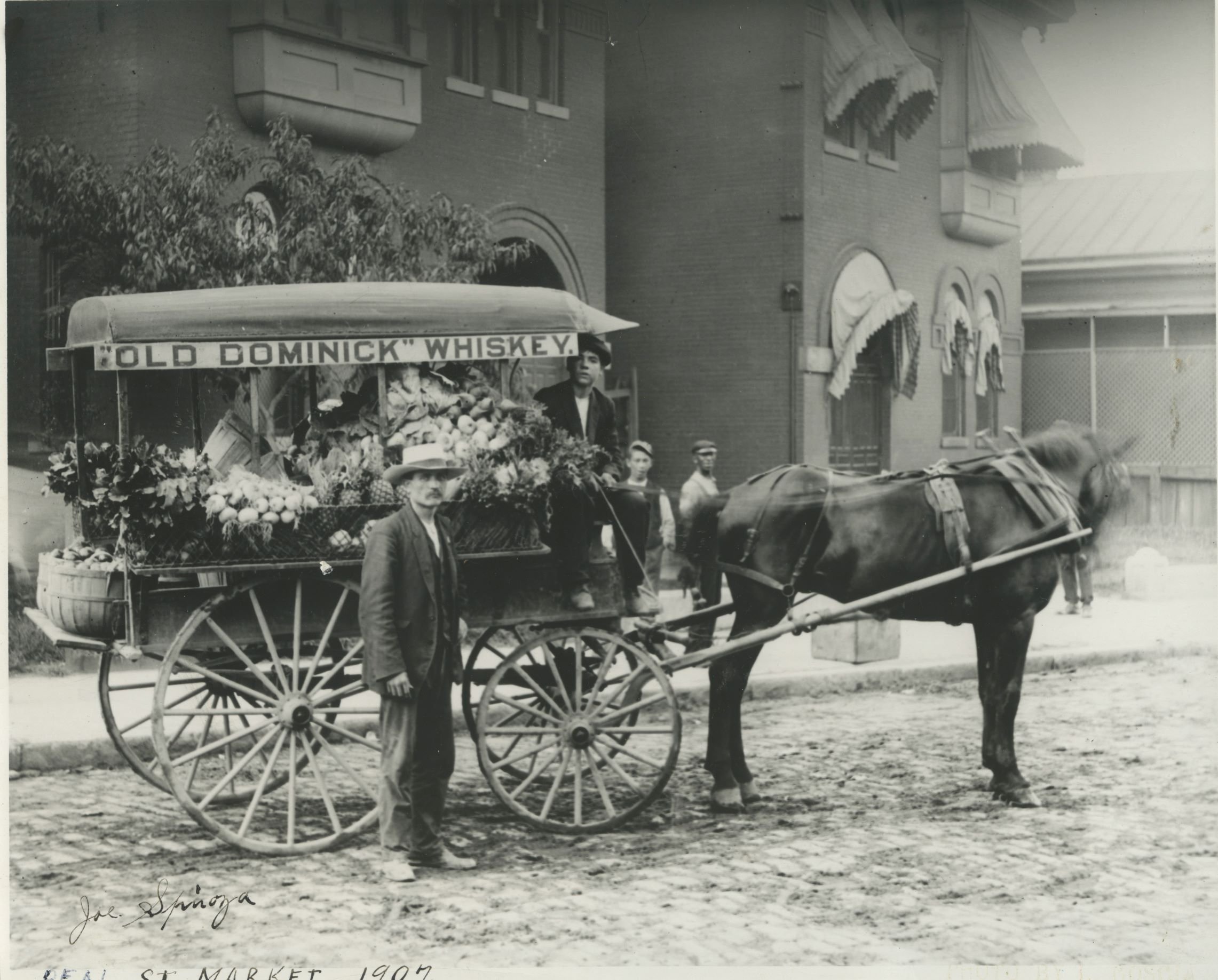Old Dominick Distillery
By Meghan Swanson
“Every book is a quotation; and every house is a quotation out of all forests and mines and stone-quarries; and every man is a quotation from all his ancestors.”
-Ralph Waldo Emerson
In 1866, Domenico Canale - Emerson’s contemporary, Italian immigrant, and fruit stand operator turned wholesaler - created a whiskey that would be recalled by his descendants over one hundred and fifty years in the future. He sourced railcars of aged whiskey from Kentucky, Indiana, and Ohio, bringing it home to Memphis where he blended and bottled it himself. He named it - what else? - Old Dominick, and cheekily slapped a Dominicker chicken on the label. The Old Dominick brand was hatched, and soon took the Southeast by storm. In 1919, Domenico passed away - just three days before Prohibition took effect in the United States. The twin blows proved too much for Old Dominick, and the whiskey brand went dormant. Still, the whispers echoed through the years and down the generations until 2013, when the Canale family would dust off Domenico’s creation and bring it forth for the pleasure of whiskey lovers in the modern era.
“I don’t think I stopped smiling once that entire day. It was exactly what you want your job to be, is what that day was.”
Unlike many folks we have met in the spirits industry, Alex Castle knew she wanted to be a part of the alchemy of alcohol production long before she hit legal drinking age. She had just begun high school when she turned onto the trajectory that would launch her to the title of Master Distiller at Old Dominick Distillery. “Until I was about 14 years old, I was dead-set, I knew I was going to be a marine biologist…then I took biology my freshman year of high school and realized it was the worst thing ever. So I had a bit of a mid-life crisis at the age of fourteen.” she confesses with a smile. Fortunately, she branched out into other STEM classes and her love affair with science continued. She credits this partially to a dynamic, inspiring chemistry and physics teacher; she fondly recounts how, on St. Patrick’s day, he encouraged his students to celebrate his Irish ancestry by setting flaming green shamrocks alight right on their laboratory tables.
Still, young Alex needed a path to hold in her mind as she made her way through her studies. Her mother, sensing Alex’s need and also mindful of Alex’s older brother who was about to graduate, had been researching majors and career paths for her children. When she brought up chemical engineering as a major, Alex’s interest was piqued. But what, she asked her mom, could she do with that degree that wasn’t teaching? Alex wasn’t interested in becoming an educator, which is a path many math and science enthusiasts take. Though her mom wasn’t, and still isn’t, much of a drinker, she responded right away with two career ideas: Master Distiller or brewer. A light came on for Alex. “She said those two things, and something about them clicked. I still to this day don’t really know what it was, I really don’t know what drew me to them. I was like ‘That’s what I’m gonna do.’” she recalls.
Alex would go on to attend the University of Kentucky for her degree in chemical engineering. She landed a co-op (an arrangement common to engineering students where a student can pursue their studies while gaining paid work experience with a company) with Alltech, a company headquartered in Lexington. She had chosen them for the chance to work at the small brewery they operated. Her boss at Alltech was in charge of the brewery, and he encouraged the young engineer’s interest. “He would let me go every other Friday to help on the bottling line. It was not a glamorous job at all but I loved it. I loved every minute that I could spend down there.” she remembers. Freshly 21, Alex was off and running down the path she’d chosen back in her freshman year of high school.
In a serendipitous turn of fate, rumors began circulating that Alltech was planning to start a distillery in addition to their brewery. The rumors were true; soon, two massive copper pot stills appeared. Alex, eager to learn any way she could, volunteered to clean them after their long journey from Scotland. “I don’t like heights, so the idea of getting on a ladder to clean the top was terrifying. But I did it, because I thought, ‘This is how you get your foot in the door.’” she tells us. Pushing through her fear paid off when the Master Distiller asked her one day if she’d like to watch a distillation. Alex jumped at the chance, and they arranged to meet the next morning. When their appointed time rolled around, the distiller realized he had double-booked himself and needed to take his kids to the dentist. He gave the completely green Alex a five-minute rundown of everything to do with distillation, and then simply left her to it. “That’s how I learned to distill.” she says with a laugh. “In that day, as terrified as I should have been, I fell in love. I knew - as much as I enjoyed the brewery aspect of it - I knew that day that I needed to make spirits.” she explains. She still has a bottle of that first distillate she ever made, and it has traveled with her on every new endeavor since.
“Reviving an existing brand is in some ways easy, but in other ways it is incredibly challenging.”
Though Old Dominick as a brand had gone dormant a hundred years or so ago, D. Canale, Domenico’s wholesale business, had stayed active and flourished through the decades. Somewhere in the Canale family offices, a memento of Domenico’s whiskey work languished. A full bottle of Domenico’s Memphis Toddy, a flavored bourbon he was quite proud of, still sealed with wax. One day at a meeting, it was pointed out that Domenico’s old brand was probably quite valuable - especially given the soaring popularity of craft whiskey at the time. “That, honestly, is what set the lightbulb off, was the idea of ‘Oh, crap, we are sitting on something that might be valuable.’” Alex explains. Additionally, by 2013 D. Canale didn’t have any public-facing businesses within Memphis any longer; the family liked the idea of bringing back a business to Memphis that would make them a household name again. Chris Canale along with his first cousin, Alex Canale, Domenico’s great-great grandsons, decided to run with the idea, settling on plans to open a distillery and bring the Old Dominick brand out of hibernation. The state of Tennessee had recently voted to allow distilling again all over the state (outside of the three counties that had traditionally always been allowed to distill), so the new distillery could fully operate right there in Memphis. “By doing a true distillery and having our tasting room and all of that, we are saying ‘Memphis, come to us. Come see us. We are here.’” Alex Castle says.
Alex herself didn’t come into the picture until two years later. She was working at Wild Turkey in Kentucky alongside legendary Master Distillers, Jimmy and Eddie Russel (after a one-year stint making Snuggle laundry detergent right after graduation) when a consulting firm that was working with Old Dominick reached out to her on LinkedIn. Did she know anyone who could move to Memphis to start up a new distillery? Alex gave it some thought, and then sent her own resume in. “I knew it was a once-in-a-lifetime opportunity.” she explains. Not only would she be getting to continue growing in her distilling career, she’d be able to put her own stamp on everything about the new distillery - from the mash bill on down to helping to pick the bathroom tile in the visitor’s center.
The plan couldn’t have been simpler - on paper. Old Dominick Distillery would simply use the exact logo from the original Old Dominick whiskey. Once they began to work with branding firms, however, they realized what Domenico had used in the 1800s was going to make things tougher for them in the 2010s. Memphis branding firm Red Deluxe, in a bold move, redesigned the Old Dominick logo unprompted and presented it to the distillery. They explained that the original logo’s curve would make applying it to physical objects difficult; they would have to design everything around the logo. To prevent the headache of extra design work on every object they wanted to brand, they suggested that Old Dominick use a nearly-identical version of the logo but without the curve. “It was interesting to see specifically Chris, and the Canale family, have to kind of separate from that original brand and acknowledge that, ‘Okay, we can do an old brand and pay respect to it, but we can do it in a modern way.’” Alex recalls.
“We always wanted to have that historic feel, that historic reference in everything we’ve done while also balancing the fact that we’re a new brand. The way we’re doing things now is not the way Dominico did them.”
Advertisements for the Memphis Toddy from Domenico’s time shine with the pride he took in his creation. It was obvious that the flavored bourbon would have to be a cornerstone of Old Dominick Distillery. There was one problem, however - “While this family was very good at documenting things, they apparently decided to throw the recipe for the toddy away or never wrote it down, because we have yet to find it.” Alex says. “It was a product we could tell from the ads that Dominico loved and promoted and did a lot of, so it was important that we figure out a way to do our version of it to pay respects to that effort.” she explains. Fortunately, they still had that original bottle of Memphis Toddy that started the whole Old Dominick Distillery brand into motion. Off went the contents to a laboratory. “We took the liquid from the bottle and had it analyzed at a lab, and were able to find out through that analysis what we thought the ingredients were in it.” Alex tells us.
We were dying to know - did anyone taste the Memphis Toddy from the 1800s? Alex laughs. “I have not tasted the liquid, I have zero interest in tasting the liquid.” she states firmly. “You have to think that, regardless of the base spirit, they were using botanicals. Most likely not even dried botanicals, it was probably fresh fruit because one of the things D. Canale sold was fresh fruit. You have to think if something was about to turn, they probably chucked it into the toddy.” she hypothesizes. Fruit doesn’t age well in any form - particularly in low-proof alcohol. The original Memphis Toddy had probably oxidized in the 150 years it had been sitting on a shelf. Though it had aged in an unappealing fashion, it was still an important key to getting the modern version of the Memphis Toddy right. “We did our best - we couldn’t even base it off of the flavor of that bottle because, that bottle, the liquid was black.” she laughs.
Although the original bottle was now unfit to drink and no one was still alive that remembered the taste of the Memphis Toddy, they persisted. “Being able to do this product, whether it’s close to the original or not, was important for the brand, and specifically the family, because it is a direct line to our founding.” says Alex. What they came up with is a delightful tribute to the original, a bourbon laced with a subtle interplay of warming spices that dances sweetly on the tongue. “It’s…a balancing act of making sure we’re appealing to today’s drinker, because today’s drinker is not the same there was in 1866.” Alex points out. This became apparent when they discovered the Memphis Toddy wasn’t the flagship product they had hoped. “We wanted toddy to be our flagship, but we have learned it’s a really unique product. You really have to taste it to get onboard with it.” Alex says.
“These are D. Canale recipes, just maybe not from 1866.”
Currently serving as Old Dominick Distillery’s flagship products are the Huling Station line of whiskeys. Old Dominick Distillery works with MGP of Indiana to commission their Straight Bourbon Whiskey and Straight Wheat Whiskey. In addition to bottling those spirits separately, Old Dominick also produces a blended whiskey made from both. . While Domenico probably sourced whatever he could get back in the 1860s for his whiskey blends (with fluctuating availability likely dictating the contents of what he made), Old Dominick Distillery and the Canale family were very specific about what they wanted in the modern day. “While we went to MGP and they produced it, these are our mash bills. They are unique to us, they are custom.” Alex stresses.
After taking stock of the different products MGP could make for them, Old Dominick Distillery chose a high-rye mash for their bourbon. “The reason they went with those mash bills [high rye and wheat] - and I’m super happy with both mash bills - is they wanted something unique, something that would stand out. Bourbon with that high rye content…that stands out.” Alex says. To their knowledge, she says, their Huling Station bourbon is the highest rye-content bourbon out there. “The people that say they’re high rye, they’re usually like thirteen percent, maybe twenty. We’re at forty-four percent.” she explains. That’s nearly at the 51% rye content that would qualify it to become an actual rye whiskey, instead of a high-rye bourbon. The mash bill, which Alex proudly displays right on the back of the bottle, is 52% corn, 44% rye with a balance of malted barley.
In keeping with Old Dominick Distillery’s adventurous spirit, they also selected a wheat-based mash bill. “In 2014, to start producing a wheat whiskey was actually kind of a gamble because the wheat whiskey category didn’t really exist outside of one or two brands.” Alex tells us. The Canale family and the distillery weren’t afraid of the risk; they saw that scarcity as an opportunity to create a niche product that would stand out. The mash bill for their wheat whiskey is 83% wheat, 12% corn, and 5% malted barley.
With these two unique mash bills under their belt, how did Old Domininck Distillery come around to their blended Huling Station whiskey? Alex smiles as she recounts the tale. MGP would send her samples of whiskey on a quarterly basis, and she’d taste them all in the laboratory, but never finished each glass. “I learned that, regardless of your job title, you will get weird looks if you walk down the hallway with eight glasses of whiskey at 8:00 in the morning.” she laughs. To cut down on the looks, she took to pouring the remainders of the samples into one glass because, she says, “One glass at 8:00 in the morning is not nearly as weird.” After tasting the blended concoction, she realized that she actually really liked the flavor profile. She knew blends like this had worked before - Wild Turkey’s Forgiven product, for example - and so the Huling Station blended whiskey was born. “As my boss points out, it really is a four grain whiskey. We do not ferment on four grains with it, so I do not call it a four grain, but maybe because four grain is kind of a hot thing right now maybe it can appeal to those people as well.” she points out.
“For years, let’s be honest, Tennessee whiskey has been Jack Daniels…that is Tennessee whiskey for most people. Why does it have to be? Why do we have to fit a flavor profile that was determined by one brand?”
While the Huling Station line will likely continue to be crafted by MGP for the foreseeable future, Old Dominick has been busy hand crafting their own spirits at their distillery in Memphis. In 2022, Old Dominick Distillery will be releasing their Tennessee whiskey - one they started distilling right in Memphis just as soon as the distillery was built. It’s a product that Alex has poured time and effort into, and one that will have great meaning for the future of Old Dominick Distillery. She explains that they’re not trying to be like Jack Daniels or Dickel; ““I think that’s what’s so great about whiskey, is - and you can see it in the bourbon world - how many big boys are there in Kentucky? And how many of them can you honestly say are similar to each other? They really are all very, very unique products, and everyone’s okay with that. It appeals to various types of drinkers. In my mind, Tennessee whiskey can be the exact same way.” She sees an opportunity for whiskey lovers to broaden the definition of Tennessee whiskey they hold in their minds. “If you don’t like Jack Daniels, hopefully we’re able to show you not all Tennessee whiskey is that way.” Alex contends. “Just because you don’t like them doesn’t mean you can’t like us, or even vice versa.”
While their Tennessee whiskey is distilled in house, they do source their grain from outside of the area - for now. Memphis is situated on a floodplain, which makes access to farmers difficult from a purely logistical standpoint. There is also the matter of distilling having been illegal in Memphis for the last hundred years or so; local farmers aren’t used to growing grain meant for distillation. Alex sources her grain from the same providers that Wild Turkey uses, bringing in quality corn from the Ohio River Valley, good malt from out west, and so on. In the future, she hopes to be able to source more grain for their products locally.
State law requires that Tennessee whiskey must be made using the Lincoln County Process, a step where the whiskey is filtered through charcoal before being barreled for aging. Old Dominick Distillery uses this process, though only for the Tennessee whiskey and not for their bourbon or wheat whiskeys. “If you’ve ever done a tour of the distillery, you can see a Kentuckian’s interpretation of the Lincoln County Process.” Alex jokes with a grin. Since the law doesn’t stipulate how long the filtration process has to take or what depth of charcoal should be used, Alex has scaled it way down in comparison to the ‘big guys’. The filtering step is in-line, making it a seamless part of the production process. She does it this way to avoid the reason some criticize the Lincoln County Process; some say the charcoal acts as a flavoring additive and can make the whiskey overly sweet. “Let’s be honest, Tennessee whiskey is bourbon - I’m gonna say it, I’m just putting it out there - so I wanted it to taste like a bourbon.” she explains. Old Dominick Distillery and its fans alike will certainly be anxiously awaiting the big release of this project that has been nine years in the making - or 150, depending on how you look at it.
“Our approach was…everything about the facility, from production to front of house, needed to fit the brand just like everything on that bottle needed to fit the brand.”
In a move emblematic of a certain boldness of character both Alex and the Canale family share, Old Dominick Distillery embarked on building everything about the brand at once. With a prosperous family business backing the fledgling distillery, they could afford to use consultants and advertising firms and to build the distillery while simultaneously building out the visitor’s center. Alex was in the thick of it all. She applied what she’d learned about production at Wild Turkey to the new distillery. She kept a strong focus on efficient layout, giving production the best flow she could give it. “Really just making sure that my team would have the space to do what it needed to do in an efficient - and hopefully headache-free - way.” she explains.
Old Dominick Distillery has two separate systems, one for their vodka and gin and one for their whiskey. The vodka and gin system is a pot still and a column still that can be run with it; it gives Alex the choice between the pot or column still, opening up options to make future spirits like absinthe or curacao. This is a good thing, because Old Dominick Distillery does have a bar, and as Alex explains, “In Tennessee, we’re allowed to serve cocktails but we have to produce every drop of alcohol that goes into that cocktail.” Their whiskey system begins with a column still, because they ferment on the grain (the grain would just stick to the insides of a pot still and cook). It’s followed by a very small type of pot still called a doubler. Their stills are all done by Vendome Copper and Brass Works, out of Kentucky. “They’re some of the best welders I’ve ever seen, and they know how to manipulate copper. They know what they’re doing.” Alex tells us.
True to her roots in traditional bourbon, Alex only uses 53 gallon barrels. “I have tasted a lot of whiskies that have gone into smaller barrels…and they just don’t do it for me. They don’t get what you get out of a 53-gallon barrel.” she claims. To her, whiskeys from smaller barrels can taste harsh and green. When Old Dominick Distillery was starting out, they averted the 2013-2014 barrel shortage by sourcing their own wood; they were fortunate to have abundant American white oak on a plot of Canale family land in west Tennessee. That land has since been sold, but today their cooperage still sources wood out of that region.
When it comes to aging, Old Dominick Distillery is a bit less married to tradition. Instead of rickhouses, they use a palletized system. Alex likes it in comparison because it’s much safer; it requires less people to move the barrels, reducing the likelihood of injuries in the warehouse (where the majority of distilling injuries tend to happen). It is apparent that Alex keeps the people on her team in mind just as much as she does the whiskey she’s making. Old Dominick Distillery has a vested interest not just in the quality of their product, but in the quality of their people as well. “The people aspect of what we do is incredibly important to him [Chris Canale], so we are very choosy when we’re hiring people. We want to make sure we are hiring good people, people that are right for not just the job but for the company as a whole.” Alex says. They expect the highest standards from their people not just on the distillery floor or in the tasting room, but out in the shops that carry their product, at events, and anywhere Old Dominick Distillery is being represented in the community. “We want to make sure we’re on it one hundred percent of the time. We don’t ever want someone to have a bad experience with anyone within the company.” Alex states firmly.
The clear commitment to excellence has inspired a fierce sense of pride and ownership in the brand in their Master Distiller. “We push for the highest quality product that we can, and I do love the fact that that is so important to Chris because it has allowed me to look at him and say, ‘those barrels aren’t ready. Don’t push it.’ Most people would have pushed for our Tennessee whiskey to be ready before four years…as soon as I told him ‘it won’t be ready. It will not be good.’ that whole quality thing clicked…he said ‘okay, we’re not gonna touch it until at least four years.’” Alex recounts. Her excitement is contagious. “We’re about to get to the biggest thing that we’ve been working towards…where everything we’ve set out to produce will finally make it into a bottle and onto store shelves, hopefully.” she says.
“I couldn’t be more proud to be able to have done that and be a part of it.”
Though she has no actual ownership stake in the Old Dominick brand, Alex is as proud of it as a Dominicker hen of her chick. “When I walk into that building [Old Dominick Distillery], it is mine. I absolutely own the brand alongside of the Canales and everyone else that was a part of the project at the time.” she says with a smile. Old Dominick Distillery and Alex are continuing to push forward, continuing to innovate through efforts like their Small Batch R&D Series. (Their latest release, All the Cookies Bourbon, she describes as tasting like “literally bourbon with an oatmeal raisin cookie shoved into it”.)
We think that Alex says it best, however, when we asked her to explain the ‘Set the Bar’ catchphrase used for the Huling Station line. “You can use ‘set the bar’ in a couple different ways. Yeah, you’re setting the bar from a standards perspective, so we’re saying we’re going to make sure our quality is here [gestures indicating a high level]...it’s gonna be better than most things you’ve ever had. But, also, ‘set the bar’...well, I’m gonna have you over to the house. I’m gonna set the bar for you.” she explains. Alex Castle and the Canale family want to set the bar for you, to share 150 years of Memphis history with you. Come to Old Dominick Distillery - try the Memphis Toddy, and find out what all the fuss is about - and raise a glass to old Domenico, who made it all possible.
TASTING NOTES
Huling Station Straight Wheat Whiskey (45% ABV)
Nose: Vanilla, Leather, Grapefruit, Raw Honey
Palate: The mouthfeel is creamy and mild up front. Notes of leather give way to vanilla and caramel. The sweetness turns to shortbread crust along with tart lemon custard on the mid palate. Sweetness fades as slight hints of oak arise alongside hearty whole wheat bread flavors on a short finish.
This is a mild but still very flavorful whiskey. The creamy mouthfeel and sweet flavors up front are very inviting and the transitions from the front of the palate to the finish are seamless and smooth. This would make for a nice sipping whiskey.
Huling Station Straight Bourbon Whiskey (50% ABV)
Nose: Icing Sugar, Orange Peel, Cinnamon, Clove
Palate: The mouthfeel is a bit sharper on the palate. There is subtle vanilla sweetness with heavier wood notes up front. A burst of cinnamon pulls you into the mid palate with some baked apple that lingers from then on. Spicier pepper notes and smoke join the apple on a long finish.
This is a much bolder whiskey than the wheat whiskey. The higher proof and spicier profile give it more body. Unlike the smooth transitions of flavor on the wheat whiskey, the transitions on the bourbon announce themselves with vigorous enthusiasm. As possibly the highest high rye bourbon out there, it certainly doesn’t drink like a traditional bourbon, so fans of that style may not appreciate it. That said, those who like both bourbon and rye probably will. The body and intensity of flavor also help this whiskey stand up nicely in a cocktail.
Huling Station Blend of Straight Whiskeys (50% ABV)
Nose: Herbal, Grassy, Dried Ginger, Leather, Copper
Palate: The mouthfeel is soft up front, and overall a pretty even balance between the previous two whiskeys. The front of the palate is delectable and sweet like a cheesecake brownie. Cinnamon is present again on the mid palate but less pronounced than in the bourbon. Black pepper and ginger round out a medium finish.
This whiskey takes positive elements from both styles that were used to create it, though we feel that overall it is a bit muted compared to either of the individual parts. That said, it’s still very enjoyable to drink.
Devil’s Water Bourbon (57.1% ABV)
Nose: Caramel Toffee, Cookie Dough, Evergreen Trees,
Palate: The mouthfeel is prickly with building heat. There is a blast of dark cherry sweetness up front that immediately gives way to hot cinnamon candy and chili pepper. Sweetener notes circle back around with vanilla and strawberries on a medium finish.
The heat on this whiskey is intense, but the flavors that exist behind that heat are beautiful. A little bit of water helps to open this whiskey up a bit more, and we love how the sweetness plays along with the heat. We don’t usually highlight this, but this whiskey has a beautiful color on it, leaning into some beautiful ruby red hues.
Memphis Toddy (30% ABV)
Nose: Lemon, Honey, Sarsaparilla, Cardamom, Chai
Palate: The mouthfeel is delicate and viscous with cinnamon and vanilla up front. Cinnamon continues to play strong throughout with cardamom, nutmeg, fresh ginger and sugar on the finish.
This is dangerously easy to drink, and at the end of a cold winter night it was just about perfect. It is very sweet so if that is not your thing then drinking it straight may not be for you, but it would make for a great digestif or mixer.
